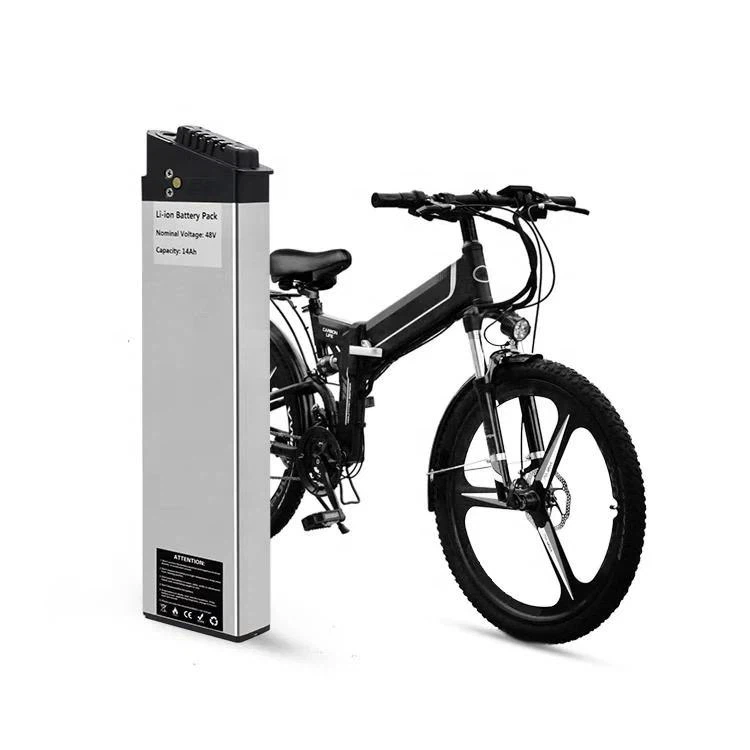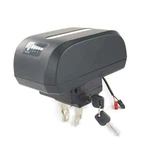As a trusted manufacturer of 48V Ebike Battery, we understand the importance of keeping your ebike powered, even in challenging situations. If you find yourself without a charger-whether on a remote ride, camping, or simply misplaced your charger-there are alternative ways to charge your 36V ebike battery. This guide provides safe, practical methods to charge your battery, along with essential safety tips and recommendations to protect your battery's lifespan and ensure your safety.
1. Understand Your 48V Ebike Battery Before Charging
Before attempting alternative charging methods, familiarize yourself with your 48V ebike battery:
- Voltage Basics: A 48V battery has a nominal voltage of 48 volts, but when fully charged, it reaches approximately 54.6 volts for lithium-ion batteries. Exceeding this voltage can damage the battery or pose safety risks.
- Battery Chemistry: Most 48V ebike batteries are lithium-ion, valued for their high energy density and longevity (typically 500–1000 charge cycles). Always verify your battery's specifications via its label or manual.
- Battery Management System (BMS): The BMS regulates charging and discharging, protecting against overvoltage, undervoltage, and overheating. However, it cannot fully mitigate incorrect voltage or current inputs.
- Risks of Improper Charging: Using incompatible voltage or excessive current can shorten battery lifespan, impair the BMS, or, in rare cases, cause overheating or fires.
Tip: Review your battery's manual for voltage, capacity (Ah), and charging requirements. If unsure, consult a professional to avoid potential issues.

2. Alternative Charging Methods Without a Charger
Below are seven reliable methods to charge your 48V ebike battery without a standard charger, each with detailed instructions and safety considerations.
2.1. Using a Universal Power Supply (Adjustable DC Power Supply)
An adjustable DC power supply provides precise control, making it a dependable alternative to a dedicated charger.
- What You Need: A universal power supply (40–60V range, 5A max), alligator clip cables, digital multimeter.
- Steps:
- Set the power supply to 54.6V and limit current to 2–3A.
- Use a multimeter to confirm the output voltage before connecting.
- Connect the red (positive) cable to the battery's positive terminal and black (negative) to the negative terminal.
- Monitor the battery voltage and stop charging at 54.6V to prevent overcharging.
- Why It Works: Offers customizable voltage and current settings, mimicking a standard charger.
- Safety Note: Select a power supply with overcurrent protection and monitor the setup continuously.
2.2. Using a Car Battery + Step-Up Converter
A 12V car battery with a boost converter can charge your 48V battery in emergencies.
- What You Need: A 12V car battery, DC-DC boost converter (48V–54.6V output, 3–5A), multimeter, insulated cables.
- Steps:
5. Configure the converter to output 54.6V and limit current to 2–3A.
6. Connect the converter's input to the car battery (positive to positive, negative to negative).
7. Attach the converter's output to the ebike battery, ensuring correct polarity.
8. Check voltage, current, and temperature every 15–30 minutes to avoid overheating.
- Why It Works: Leverages a vehicle's power for on-the-go charging.
- Safety Note: Car batteries can deliver high currents, risking damage if unregulated; use only as a temporary solution.
2.3. Charging with a Solar Panel System
Solar panels offer an eco-friendly charging option, suitable for off-grid scenarios.
- What You Need: A 150W–200W solar panel, MPPT solar charge controller (48V–54.6V output), weatherproof cables.
- Steps:
9. Position the solar panel in direct sunlight and connect it to the charge controller.
10. Set the controller for a 48V lithium-ion battery (~54.6V output).
11. Connect the controller's output to the battery, verifying polarity.
12. Monitor the controller's display and stop at 54.6V.
- Why It Works: Harnesses renewable energy for sustainable charging.
- Safety Note: Use an MPPT controller for efficiency and protect against voltage fluctuations. Charging may take 8–12 hours for a 10Ah battery.
2.4. Using a High-Capacity Power Bank
A power bank with a high-voltage DC output can provide a partial charge for short-term needs.
- What You Need: A power bank with 48V–54.6V DC output (3A), compatible adapter cable, multimeter.
- Steps:
13. Confirm the power bank's output matches your battery's requirements.
14. Connect the power bank to the battery using the adapter.
15. Monitor voltage and stop when the power bank depletes or the battery reaches 54.6V.
- Why It Works: Compact and portable for emergency use.
- Safety Note: Most power banks lack sufficient capacity for a full charge, making this a temporary solution.
2.5. Battery-to-Battery Parallel Charging
This method transfers charge from a fully charged 48V battery to a depleted one via parallel connection.
- What You Need: Two 48V lithium-ion batteries, high-quality insulated cables, multimeter.
- Steps:
- Verify both batteries are 48V and compatible in chemistry and capacity.
- Connect positive terminals together and negative terminals together using thick cables.
- Check voltages every 10–15 minutes; disconnect when they equalize or the depleted battery reaches ~53V.
- Why It Works: Requires no external power source.
- Safety Note: Risks current imbalances or battery stress; use cautiously and infrequently.
2.6. Charging at Public Ebike Charging Stations
- Public charging stations in urban areas provide a convenient option.
- How to Use:
19.Locate a station using ebike charging apps or local maps.
20. Ensure the station's output matches your 48V battery (~54.6V max).
21. Plug in your battery or bike and follow payment instructions (e.g., QR code).
- Why It Works: Accessible and often equipped with safety features.
- Safety Note: Carry a universal adapter to ensure compatibility with varying connectors.
2.7. Using a Generator + Ebike Charger
A portable generator powers a standard charger for reliable off-grid charging.
- What You Need: A 500W–1000W generator, 48V ebike charger, extension cords.
- Steps:
19. Start the generator in a well-ventilated area and connect the charger.
20. Plug the charger into the battery, confirming polarity.
21. Monitor as you would with a standard charger.
- Why It Works: Effective for remote locations without grid access.
- Safety Note: Use an inverter generator for stable power and follow fuel safety guidelines.
3. Safety Guidelines for Charging Without a Charger
Safety is critical when charging without a standard charger:
- Monitor Parameters: Use a digital multimeter to ensure voltage stays within 48V–54.6V and current below 3A (or your battery's rating).
- Prevent Overcharging: Stop charging at 54.6V to avoid damaging the BMS or causing overheating.
- Insulate Connections: Use insulated cables and inspect for wear to prevent short circuits.
- Choose a Safe Environment: Charge in a cool, dry, ventilated area, away from flammable materials or direct sunlight.
- Stay Vigilant: Check the setup every 15–30 minutes for overheating or unusual smells.
- Be Prepared: Keep an electrical fire extinguisher nearby and know how to disconnect the system quickly if needed.
4. Pros and Cons of Each Method
|
Method |
Pros |
Cons |
|
Universal Power Supply |
Precise control, reliable with proper setup |
Requires technical skills, equipment investment |
|
Car Battery + Converter |
Accessible in vehicles, suitable for emergencies |
Risk of overcurrent, complex setup |
|
Solar Charging |
Eco-friendly, ideal for off-grid use |
Weather-dependent, slower charging, higher initial cost |
|
Power Bank |
Portable, user-friendly |
Limited capacity, slow or partial charging |
|
Battery-to-Battery |
No external power required |
Potential for imbalance, risky if mishandled |
|
Public Stations |
Convenient in urban areas, often secure |
Limited availability, possible costs or compatibility issues |
|
Generator + Charger |
Dependable off-grid solution |
Noisy, fuel-dependent, less portable |
5. Final Recommendation: Choose the Safest Option for Your Scenario
For consistent use, we recommend investing in a spare original charger or a cost-effective universal power supply to ensure compatibility and safety. For outdoor or off-grid adventures, a solar panel with an MPPT controller is a sustainable choice, though it requires patience due to slower charging times. In emergencies, a car battery with a converter or a power bank can work, but monitor closely to avoid risks.
Always prioritize safety by using high-quality equipment, adhering to your battery's specifications, and following safety guidelines. For frequent charging needs, consider a modular battery system for easier power management.
6. Frequently Asked Questions
Q1: Can I charge my 48V ebike with a 12V car battery directly?
No, you must use a DC-DC step-up converter to safely adjust the voltage to 48V–54.6V.
Q2: Will these methods damage my battery?
If voltage and current are not properly controlled, yes. Always use a multimeter and match your battery's specifications.
Q3: What is the full charge voltage for a 48V battery?
Typically 54.6V for lithium-ion batteries.
Q4: How long does it take to charge with solar or a power bank?
Solar charging with a 150W panel may take 8–12 hours for a 10Ah battery, depending on sunlight. Power banks often provide partial charges and take longer due to limited capacity.
Q5: Can I use a laptop charger to charge my ebike battery?
Most laptop chargers (e.g., 19V) are incompatible. You need a charger with adjustable 48V–54.6V output, which is uncommon for laptop chargers.
Look for high-quality electric bicycle battery manufacturers
GEB is a professional manufacturer of lithium batteries for electric bicycles. Our factory was established in 2009 and is located in Shenzhen. At present, we have over 180 employees and an annual sales volume exceeding 30 million US dollars, making us a leader in the electric bicycle battery industry. We hold multiple authoritative certifications in Europe and America such as UL, CE, and RoHS, as well as other local quality and environmental protection certifications in Europe and America, ensuring that our products meet the market access standards of Europe and America. Contact us now to learn more about 36V electric bicycle batteries. ( sales@gebattery.co )










